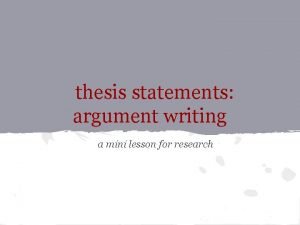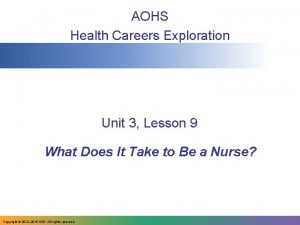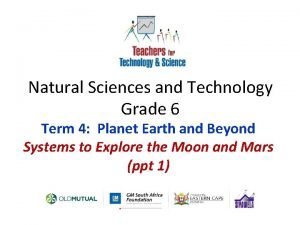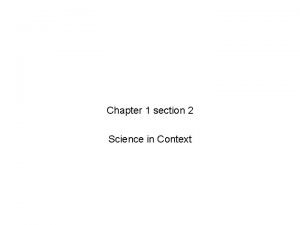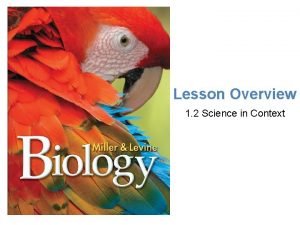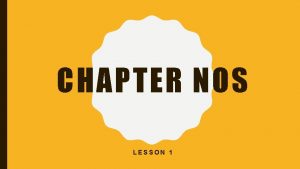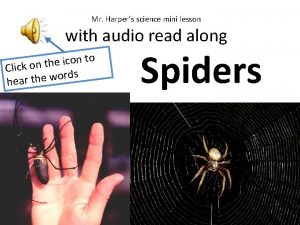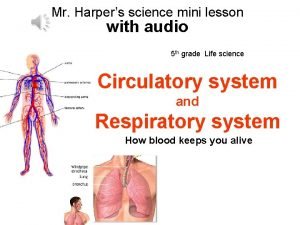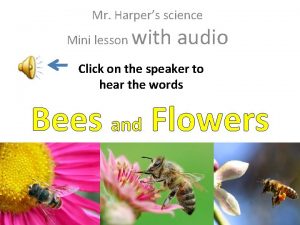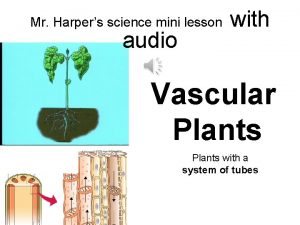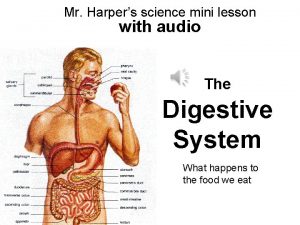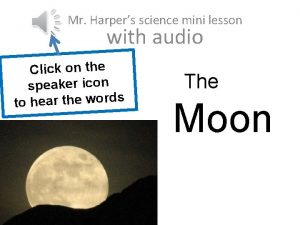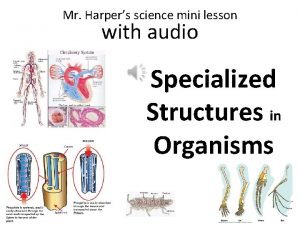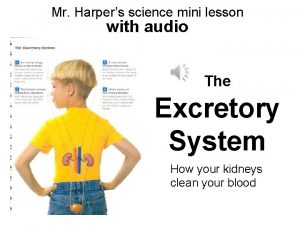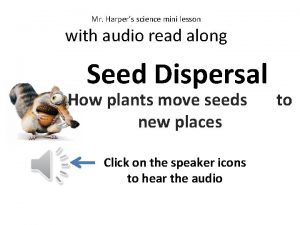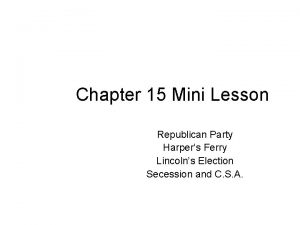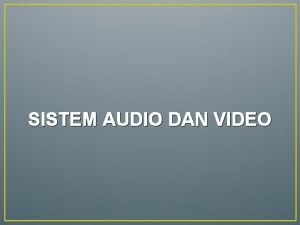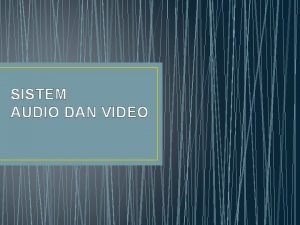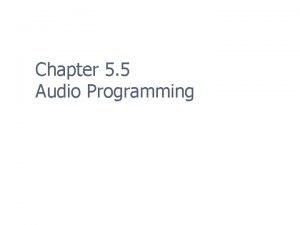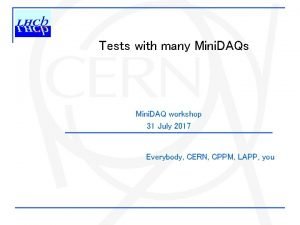Mr Harpers science mini lesson with readalong audio
































- Slides: 32

Mr. Harper’s science mini- lesson with read-along audio Different Types of Animals Click on the speaker icons to hear the spoken words

All animals must breathe in oxygen to live. Oxygen in CO 2 out Oxygen in CO 2 out All animals must release carbon dioxide to live.

All animals must eat to get the energy to live and grow.

All animals are alike in that they need oxygen and food. Now let’s look at some differences between the types of animals.

Every animal is either a vertebrate or an invertebrate. Vertebrates are the animals that have a backbone or spine.

Animals that have no backbone are called invertebrates.

Another difference is that some animals are warm blooded and some are cold blooded. Infrared photography shows how warm things are. The dog is a warm blooded mammal. The lizard is a cold blooded reptile but the hand holding it belongs to a warm blooded mammal.

Warm blooded animals include all mammals and all birds. Their bodies use the energy in food to keep their bodies warm, ever if it’s cold where they are.

Cold blooded animals, like reptiles, insects and fish can’t heat their bodies. Reptiles like to lay in the sun when they can to get warm.

Mammals mammals are warm blooded. They have to eat more often than cold blooded animals because mammals burn food energy to stay warm.

Marine mammals like whales, dolphins and seals must come to the surface to breathe air. All mammals breathe air.

All mammal are vertebrates. Every mammal has a backbone as part of its skeleton. backbone

All mammals give birth to live babies, but so do some reptiles and fish.

What makes mammals special is that mammal mothers all give milk to feed their new babies. No other type of animal can do that.

Another thing that makes mammals special is fur or hair. Only mammals have hair on their bodies. Even whales have some hair.

Birds all reproduce by laying eggs. Bird parents keep their eggs warm until they hatch. All birds are warm blooded vertebrates. backbone

Birds feed their babies but they don’t give them milk.

The thing that makes birds special is feathers. Only birds have feathers to cover their bodies.

Reptiles are all cold blooded. Most reptiles lay eggs but some give birth to live babies.

Reptiles shed or molt the outer layer of their skin as they grow when the old skin gets too small.

The thing that makes reptiles really different from other animals is that their bodies are covered with scales. This helps them live in places with very little water.

There also reptiles that spend most of their life in water, but they all breathe air for the oxygen they need.

Amphibians are a lot like reptiles. Amphibians They are cold blooded and most lay eggs when they reproduce. But amphibians have smooth skin instead of scales.

Amphibians lay their eggs in water. When they hatch, they have no legs. They swim and breathe water with gills for a few weeks.

As they get older and bigger, legs begin to appear. By the time an amphibian is an adult, it has four legs, and lungs that must breathe air. The gills are gone.

The big difference with amphibians is that they go through stages of metamorphosis as they grow up. “Morph” means “change. ” Amphibians undergo big changes in their lives.

Fish come in many different shapes and sizes, but they all share these characteristics: • They live in water • They breathe water with gills • They are cold blooded (have a backbone) • They are vertebrates Fish skeletons backbone

Crustaceans are water animals and breathe water with gills but they are not fish. Crustaceans are invertebrates. Instead of a backbone on the inside they have a hard outer shell.

Insects are cold blooded invertebrates. (no back bone). Adult insects have skeletons on the outside. Insects start as eggs and go through the stages of metamorphosis. Many adult insects have wings and can fly.

Adult insects have six legs and two antennae (feelers) that give information about their surroundings. Insects’ bodies have three sections; head, thorax, and abdomen.

Spiders are cold blooded invertebrates , but they are not insects. • Spiders have 8 legs instead of 6 like insects. • Spiders have 2 body segment rather than 3. 2 segments cephalothorax abdomen

There are many other interesting types of animals in the world that you can learn about.
 Readalong’s singalong
Readalong’s singalong John browns raid apush
John browns raid apush Harpers vs new yorker
Harpers vs new yorker Tenant farming definition apush
Tenant farming definition apush Foda de recursos humanos
Foda de recursos humanos Fo maxi maxi
Fo maxi maxi Anlisis foda
Anlisis foda One of my favorite subjects
One of my favorite subjects Measurement and scientific tools lesson 2
Measurement and scientific tools lesson 2 Main idea mini lesson
Main idea mini lesson External conflict in frankenstein
External conflict in frankenstein Theme mini lesson
Theme mini lesson Direct object mini lesson
Direct object mini lesson Summarizing mini lesson
Summarizing mini lesson Mini lesson on thesis statements
Mini lesson on thesis statements Magnifying glass clipart
Magnifying glass clipart What are ellipses used for
What are ellipses used for Social science vs natural science
Social science vs natural science Brances of science
Brances of science Natural and physical science
Natural and physical science Applied science vs pure science
Applied science vs pure science Anthropology vs sociology
Anthropology vs sociology K5 think central
K5 think central Rule of 70 in population growth
Rule of 70 in population growth Windcube lidar
Windcube lidar Hard science and soft science
Hard science and soft science Technology term 3 grade 7
Technology term 3 grade 7 Looking at science fiction lesson plan
Looking at science fiction lesson plan Unit 3 lesson 9 health science
Unit 3 lesson 9 health science Natural science grade 6 term 4
Natural science grade 6 term 4 Chapter 1 lesson 2 science in context
Chapter 1 lesson 2 science in context Chapter 1 lesson 2 science in context
Chapter 1 lesson 2 science in context Lesson 1 understanding science answer key
Lesson 1 understanding science answer key














